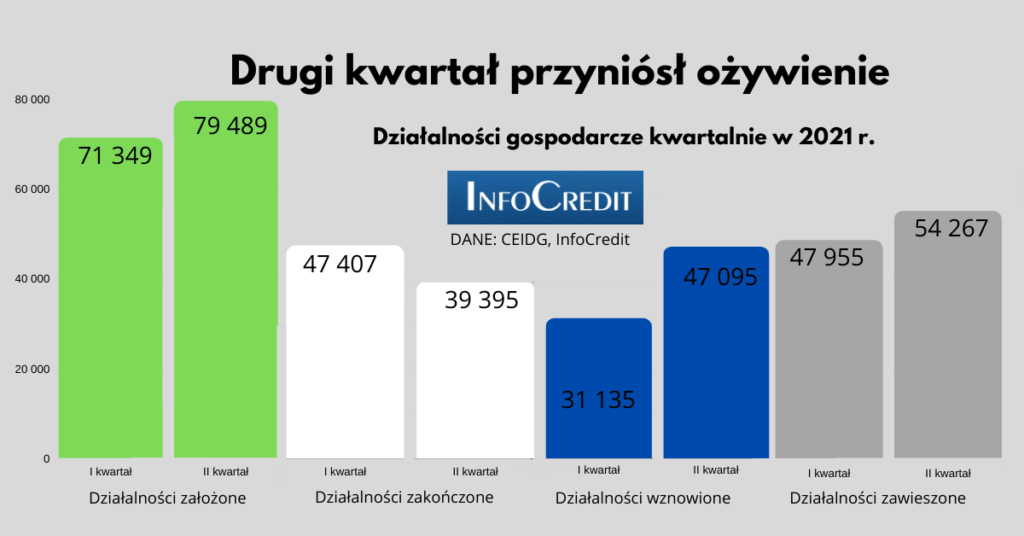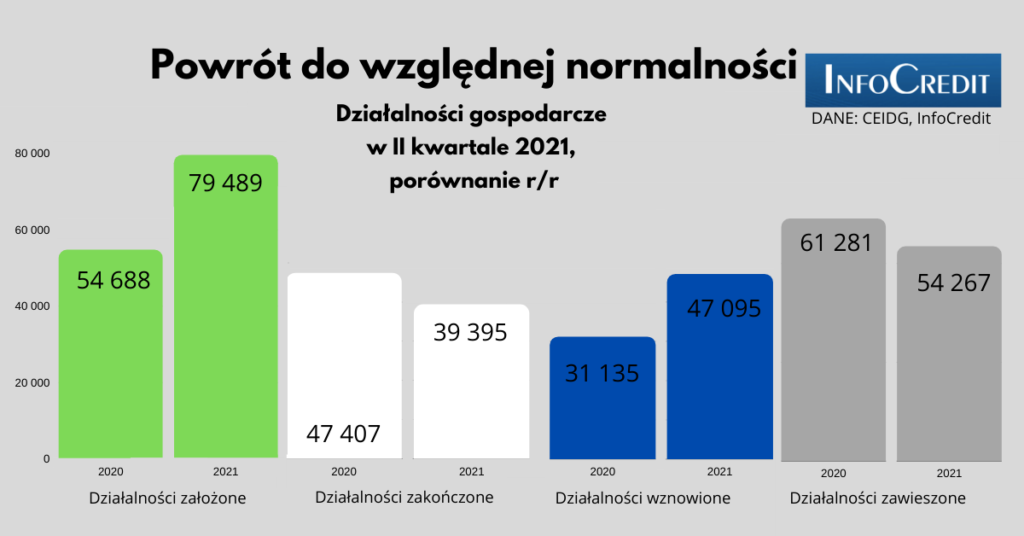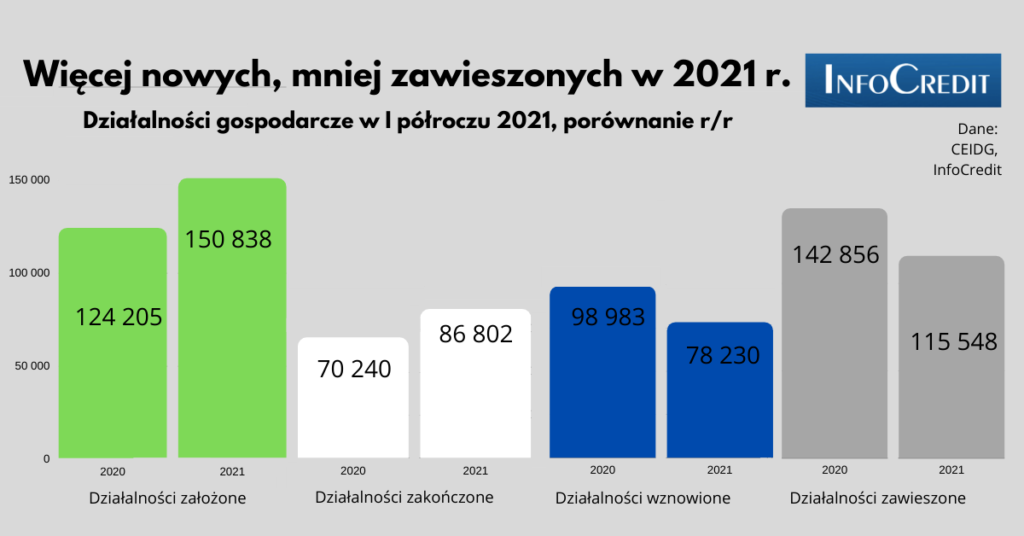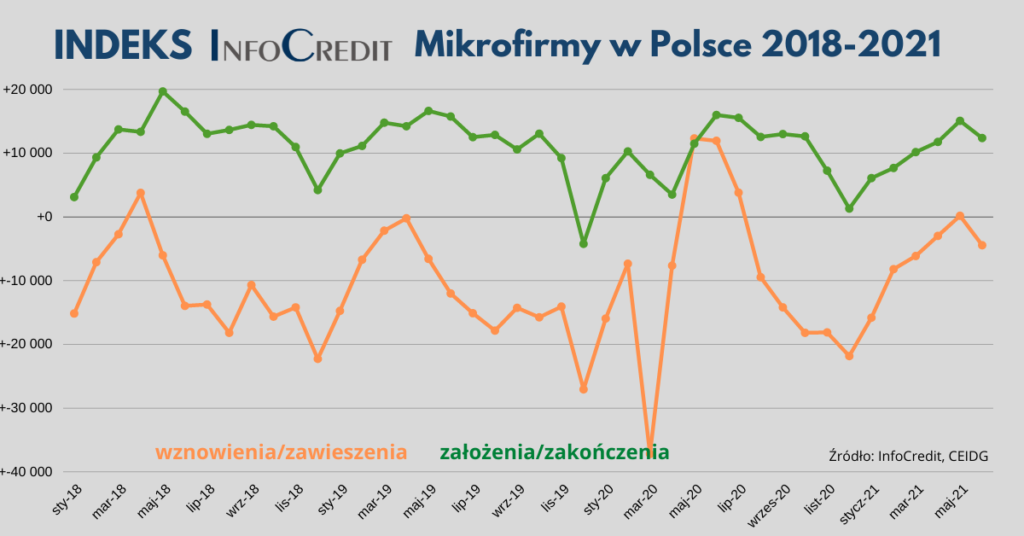Small business returns to normal
InfoCredit Microenterprise Index
In the second quarter of 2021, there was a revival in economic activity. Poles established more small businesses than in the first quarter of 2021 and in the second quarter of 2020. There were also more resumptions, fewer closures – according to CEIDG data.
In the entire first half of 2021, significantly more applications were submitted to CEIDG than a year ago. 150.8 thousand new businesses were established, compared to 124.2 thousand in the first two quarters of 2020.
InfoCredit microenterprise indices after the first half of the year are still close to the highest values this year. The indicator describing the ratio of new to closed businesses after H1 was worth +12,378 points (compared to +15,077 points after May 2021 and +15,492 after June 2020), and the indicator describing the ratio of resumed to suspended businesses was worth -4,443 points (+173 points after May 2021 and +11,929 after June 2020).
With the improvement in the economy, easing of restrictions and a decrease in COVID-19 cases, the situation in small businesses is constantly improving. Q2 2021 brought a revival in economic activity and a return to the situation that we observed before the epidemic (i.e. in Q2 2019). April, May and June of this year are difficult to compare with the same period of 2020. The past quarter for small businesses was completely different than Q2 2020.

– A year ago, we were just learning how to operate during the epidemic. The easing of restrictions took place just before the holiday season. This year, small businesses had a chance to slowly prepare for the season from April. Many small businesses that suspended their operations in March 2020 did not resume them until the end of June. This year, the seasonal suspension of operations was spread over several months and took place gradually right after the third wave of the epidemic – says Jerzy Wonka, InfoCredit’s development director.
In the second quarter of 2021, 79.5 thousand business activities were established, 39.4 thousand were closed, 47.1 thousand were resumed, and 54.3 thousand were suspended. In the same period last year, 54.7 thousand were established, 47.4 thousand were closed, 31.1 thousand were resumed, and 61.3 thousand were suspended.


The situation is similar in the entire first half of 2021. 150.8 thousand businesses were established (124.2 thousand in the first half of 2020), 86.8 thousand were closed (compared to 70.2 thousand), 78.2 thousand were resumed (compared to 99 thousand), and 115.5 thousand were suspended (compared to 142.9 thousand).
The InfoCredit index, describing the ratio of new to closed businesses, rose to its highest value this year in May (+15,077), also remaining quite high after June (+12,378 points). The indicator describing the ratio of resumptions to suspensions in May came out positive to 179 points (which does not happen often, as it has usually been negative for years), to fall to -4443 points after June. – This is not a worrying phenomenon. Usually, before the holidays, at the end of June, business activities are suspended seasonally by entrepreneurs and specialists who want to take advantage of their vacations and at the same time reduce the burdens associated with running a business – adds Jerzy Wonka.
What can we expect in the coming months? – The economic situation in the industry is great, wages are growing, the situation on the labor market is also quite good. This should favor small businesses that cooperate with large ones, and specialists who settle accounts with their clients while running their business. On the other hand – we do not know how quickly we will have to face the fourth wave of infections. And what restrictions we will have to deal with. Because the fact that another wave will occur is obvious given the current slowdown in vaccinations – adds the InfoCredit Development Director.
How do we calculate the InfoCredit Index?
The InfoCredit Index was created to track trends in micro-entrepreneurship, alternative forms of employment and self-employment at a time when the situation on the labor market and in individual industries is changing dynamically. The index, which is developed by Poland’s oldest company analyzing the economy, takes on a positive value when there are more new businesses than closures. When there are fewer than closed businesses – a negative value. In the same way, we also track the ratio of resumed to suspended businesses.
